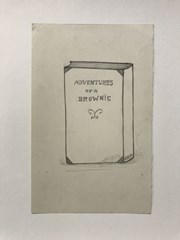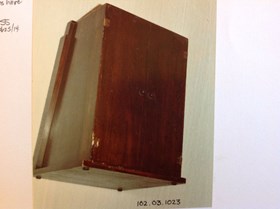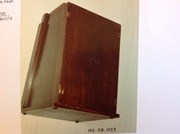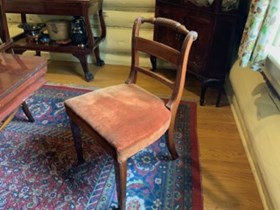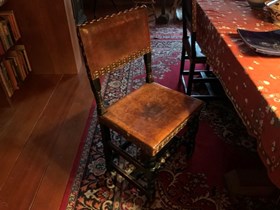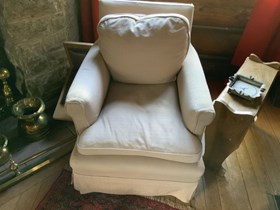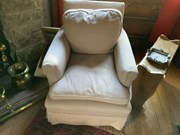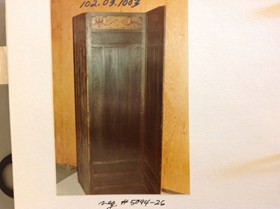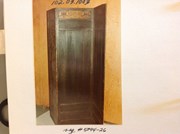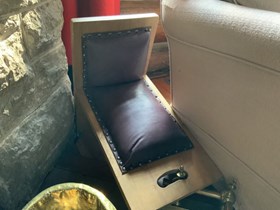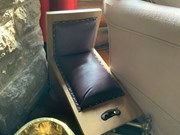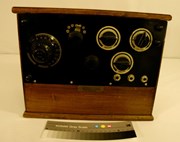Narrow Results By
Adventures of a Brownie
https://archives.whyte.org/en/permalink/artifactwyp.03.915
- Date
- 1921
- Medium
- graphite on paper
- Catalogue Number
- WyP.03.915
- Description
- A book standing upright, that has a little shading on the surface that it stands on. On the spine of the book it says “DUNLOP” and on the book cover “ADVENTURES OF A BROWNIE”.verso: a drawing of a coffee table or dining room table. In the TRC it says “Jan 5’/21”
1 image
- Title
- Adventures of a Brownie
- Date
- 1921
- Medium
- graphite on paper
- Dimensions
- 22.8 x 14.5 cm
- Description
- A book standing upright, that has a little shading on the surface that it stands on. On the spine of the book it says “DUNLOP” and on the book cover “ADVENTURES OF A BROWNIE”.verso: a drawing of a coffee table or dining room table. In the TRC it says “Jan 5’/21”
- Credit
- Gift of Catharine Robb Whyte, O. C., Banff, 1979
- Catalogue Number
- WyP.03.915
Images
This material is presented as originally created; it may contain outdated cultural descriptions and
potentially offensive content.
Read more.
- Date
- 1920 – 1960
- Material
- wood; metal
- Catalogue Number
- 102.03.1023
- Description
- Small wooden cabinet, stained dark and varnished. Two doors at front open outward from center.
1 image
- Title
- Cabinet
- Date
- 1920 – 1960
- Material
- wood; metal
- Description
- Small wooden cabinet, stained dark and varnished. Two doors at front open outward from center.
- Subject
- households
- furniture
- Credit
- Gift of Unknown, 1968
- Catalogue Number
- 102.03.1023
Images
This material is presented as originally created; it may contain outdated cultural descriptions and
potentially offensive content.
Read more.
- Date
- 1925 – 1940
- Material
- wood; metal
- Catalogue Number
- 102.03.1004
- Description
- varnished wood, branch legs with burl growth, adjustable chair back, (3 positions), made of a cross section of coniferous tree with bark edge intact, two long arm rests, on back of the top of the rests are 4 metal rods attached, a metal rod sits between these to support chair back, arms are low w…
1 image
- Title
- Chair
- Date
- 1925 – 1940
- Material
- wood; metal
- Dimensions
- 81.5 x 64.6 x 80.5 cm
- Description
- varnished wood, branch legs with burl growth, adjustable chair back, (3 positions), made of a cross section of coniferous tree with bark edge intact, two long arm rests, on back of the top of the rests are 4 metal rods attached, a metal rod sits between these to support chair back, arms are low with short branch supports with burl growth, seat is length section of conifer rounded edges, branch legs with burl growth, cross braced with same
- Subject
- households
- furniture
- Credit
- Gift of Unknown, 1968
- Catalogue Number
- 102.03.1004
Images
This material is presented as originally created; it may contain outdated cultural descriptions and
potentially offensive content.
Read more.
- Date
- 1920 – 1940
- Catalogue Number
- 102.03.0005 a-f
- Description
- A set of six ladder -back dining chairs, each with rust-coloured velvet upholstery on the seat. Each chair has rectangular brass inlay as a border trim on the back brackets and a turned wood piece as the top rail on the chair back.
1 image
- Title
- Dining Chair
- Date
- 1920 – 1940
- Dimensions
- 83.0 x 54.0 x 49.8 cm
- Description
- A set of six ladder -back dining chairs, each with rust-coloured velvet upholstery on the seat. Each chair has rectangular brass inlay as a border trim on the back brackets and a turned wood piece as the top rail on the chair back.
- Subject
- households
- furniture
- Credit
- Gift of Pearl Evelyn Moore, Banff, 1979
- Catalogue Number
- 102.03.0005 a-f
Images
This material is presented as originally created; it may contain outdated cultural descriptions and
potentially offensive content.
Read more.
- Date
- 1920 – 1930
- Material
- wood; skin; metal; fibre
- Catalogue Number
- 102.03.0087
- Description
- Leather seated, leather backed chairs, normal dining style, straight backed. Leather affixed on back and decorated with brass studs. Front legs are lathe turned, back legs are straight posts.
1 image
- Title
- Dining Chair
- Date
- 1920 – 1930
- Material
- wood; skin; metal; fibre
- Dimensions
- 94.0 x 39.5 x 47.5 cm
- Description
- Leather seated, leather backed chairs, normal dining style, straight backed. Leather affixed on back and decorated with brass studs. Front legs are lathe turned, back legs are straight posts.
- Subject
- households, furniture
- Credit
- Gift of Catharine Robb Whyte, O. C., Banff, 1979
- Catalogue Number
- 102.03.0087
Images
This material is presented as originally created; it may contain outdated cultural descriptions and
potentially offensive content.
Read more.
- Date
- 1920 – 1950
- Material
- wood; fibre
- Catalogue Number
- 102.03.0043
- Description
- Two easy chairs, with loose seat and back cushions. The original upholstery of both chairs is a loose open weave. Both chairs have been slip covered with peach cotton fabric.
1 image
- Title
- Easy Chair
- Date
- 1920 – 1950
- Material
- wood; fibre
- Dimensions
- 76.0 x 90.0 x 70.0 cm
- Description
- Two easy chairs, with loose seat and back cushions. The original upholstery of both chairs is a loose open weave. Both chairs have been slip covered with peach cotton fabric.
- Subject
- households
- furniture
- Credit
- Gift of Pearl Evelyn Moore, Banff, 1979
- Catalogue Number
- 102.03.0043
Images
This material is presented as originally created; it may contain outdated cultural descriptions and
potentially offensive content.
Read more.
Folding Screen
https://archives.whyte.org/en/permalink/artifact102.03.1003
- Date
- 1920 – 1935
- Material
- wood; metal
- Catalogue Number
- 102.03.1003
- Description
- large black stained oak folding partition screen, 3 folding sections each consisting of 2 horizontal boards at top, 4 vertical boards in middle, and 3 more horizontal boards at bottom, top board incised with stylized floral and ribbon pattern stained pink and black against green background, screen …
1 image
- Title
- Folding Screen
- Date
- 1920 – 1935
- Material
- wood; metal
- Dimensions
- 174.0 x 3.7 x 151.5 cm
- Description
- large black stained oak folding partition screen, 3 folding sections each consisting of 2 horizontal boards at top, 4 vertical boards in middle, and 3 more horizontal boards at bottom, top board incised with stylized floral and ribbon pattern stained pink and black against green background, screen sections hinged vertically to fold like accordion
- Subject
- households
- furniture
- Credit
- Gift of Unknown, 1968
- Catalogue Number
- 102.03.1003
Images
This material is presented as originally created; it may contain outdated cultural descriptions and
potentially offensive content.
Read more.
Footstool Stool
https://archives.whyte.org/en/permalink/artifact102.03.0023
- Date
- 1920 – 1940
- Material
- wood; skin; metal
- Catalogue Number
- 102.03.0023
- Description
- T-shaped footstool formed from two pieces of wood. One side of the T, one of the two right angles, is padded with red leather upholstery and brass tacks. A hand hole is placed through the end of the long leg (the stem of the T) for carrying.
1 image
- Title
- Footstool Stool
- Date
- 1920 – 1940
- Material
- wood; skin; metal
- Dimensions
- 48.0 x 28.0 x 48.5 cm
- Description
- T-shaped footstool formed from two pieces of wood. One side of the T, one of the two right angles, is padded with red leather upholstery and brass tacks. A hand hole is placed through the end of the long leg (the stem of the T) for carrying.
- Subject
- households
- furniture
- Credit
- Gift of Pearl Evelyn Moore, Banff, 1979
- Catalogue Number
- 102.03.0023
Images
This material is presented as originally created; it may contain outdated cultural descriptions and
potentially offensive content.
Read more.
The Metropolitan Museum of Art : a handbook of the American Wing
https://archives.whyte.org/en/permalink/catalogue21002
- Medium
- Library - Book (including soft-cover and pamphlets)
- Published Date
- 1928
- Author
- Halsey, R. T. H.
- Publisher
- New York : The Museum
- Edition
- 4th ed.
- Call Number
- NK2003 H3
- Author
- Halsey, R. T. H.
- Responsibility
- by R. T. H. Halsey and Charles O. Cornelius
- Edition
- 4th ed.
- Publisher
- New York : The Museum
- Published Date
- 1928
- Physical Description
- 295p. : ill. plans
- Subjects
- Furniture - U.S. - History
- House furnishings - U.S. - History
- Interior decoration - U.S. - History
- Notes
- Includes index
- Accession Number
- 3069
- Call Number
- NK2003 H3
- Location
- Art Library is located in Curatorial Department - Please contact Curatorial Department for access
- Collection
- Art Library
This material is presented as originally created; it may contain outdated cultural descriptions and
potentially offensive content.
Read more.
Peanut Tube Radio
https://archives.whyte.org/en/permalink/artifact105.04.1016%20a-c
- Date
- 1924
- Material
- wood; metal; plastic; glass; fibre
- Catalogue Number
- 105.04.1016 a-c
- Description
- A peanut tube (three-tube) radio enclosed in a varnished brown wooden box/cabinet (a) with a hinged lid. The lid has two small metal screw eyes on each side of the inside (2.0cm from the corner) attaching it to the cabinet which has two metal hooks (2.0cm down from the front corner) screwed into pl…
1 image
- Title
- Peanut Tube Radio
- Date
- 1924
- Material
- wood; metal; plastic; glass; fibre
- Dimensions
- 26 x 18 x 32.5 cm
- Description
- A peanut tube (three-tube) radio enclosed in a varnished brown wooden box/cabinet (a) with a hinged lid. The lid has two small metal screw eyes on each side of the inside (2.0cm from the corner) attaching it to the cabinet which has two metal hooks (2.0cm down from the front corner) screwed into place on both sides. These are used to close the lid securely to the main cabinet. A paper diagram of the circuitry board is tacked to the obverse side of the lid with six metal thumbtacks. The diagram outlines the blueprint of the radio (b), which is separate from the cabinet; the radio slides out of the front from two grooves cut into the sides of the cabinet. The cabinet has two holes bored into the back to attach it to a wall. The front of the radio has a plastic panel secured in place to the base, which is a flat piece of wood, by the dials etc. and four screws on the bottom. Extreme left in the top and bottom corner are two small black plastic knobs; the top knob is the antennae, the bottom is the ground knob. In between these to the middle left is a large plastic knob, black with degrees marked in white, adjustable control (0 increasing by 10’s to a 100 degrees) for station tuning; the small knob in centre (starting at 0 increasing by 5 degrees to 2, then 3, both left and right) is for fine tuning. Next, to the top right is an adjustable black knob with a bent metal contact piece attached; it moves left and right moving to make contact with five metal posts used for switching to different radio bands; two metal posts, one at either end, are used to keep the metal contact piece within the five contact points radius. Below this is a plain black plastic adjustable knob used for sensitivity control for the strength of radio station waves. This goes in and out, further and closer, (it is attached to wires covered with a textile). To the right of these are three black plastic knobs adjustable rheostats (that control the filaments of the three tubes inside (R215-A Vacuum tube); this is the volume control. Three nuts (jack has a thread on it to keep in place) are for jacks for headphone output. Jack 3, closest to the edge of the radio, also controls the switch to the speaker (if you want to have a speaker hooked up to loudspeaker). There are two wires attached different colours; they have a sleeve on the corners so it doesn’t short-circuit.The headphones (c) are hard plastic earpieces (6 cm. in diametre); one has a metal back with “FROST (F)ONES NO. 161 1000” , and three screws underneath the lettering; the other is black hard Bakelite plastic with “National” written in script ,“ELECTRIC” in the tail of the L, underneath that “OHMS 100C SINGLE”, two screws and nuts attaching two-fibre covered wires on either side that connect to the plastic and metal jack plug, “MNFD. BY THE NATIONAL ELECTRIC HEATING COMPANY LIMITED TORONTO CANADA”. Each earpiece has a metal piece attached by rivets to each side allowing it to move. The two-band fibre-covered headpiece is connected to the metal piece by two metal wires. The two fibre-cover wires extending from the earphones are joined and covered with a black cord wound around until it forms a loop which is knotted to close. Two plugs that fit into the jack attachment BARKEKLEW SERIESPAT. PENDING NUMBERS 1,2,3,4, negative on the left side and positive on the right making 8 hole plugs, 2 screws in the place attaching to the metal jack that plugs into the radio.Blueprint hand drawn for back.
- Subject
- households
- furniture
- entertainment
- Credit
- Gift of Lorne Cooley, Banff, 2008
- Catalogue Number
- 105.04.1016 a-c
Images
This material is presented as originally created; it may contain outdated cultural descriptions and
potentially offensive content.
Read more.


